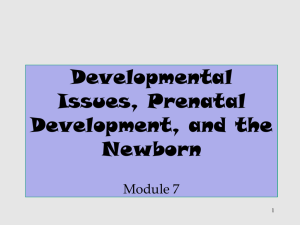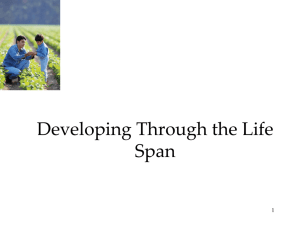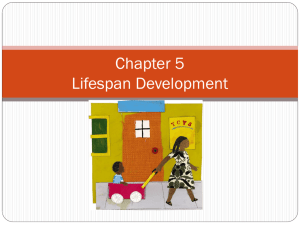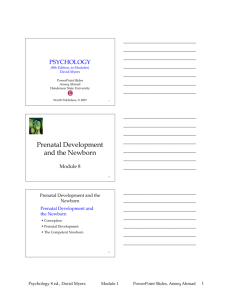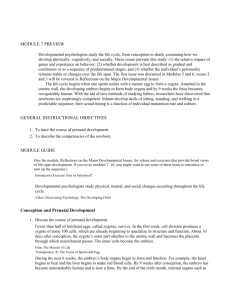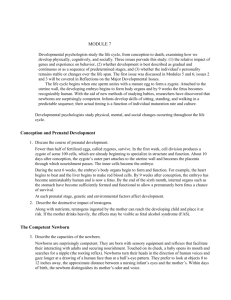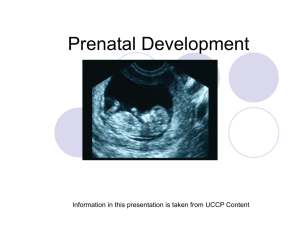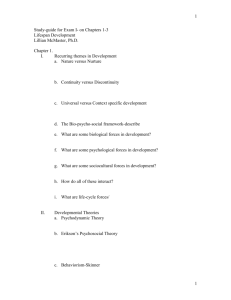Prenatal Development and the Newborn
advertisement
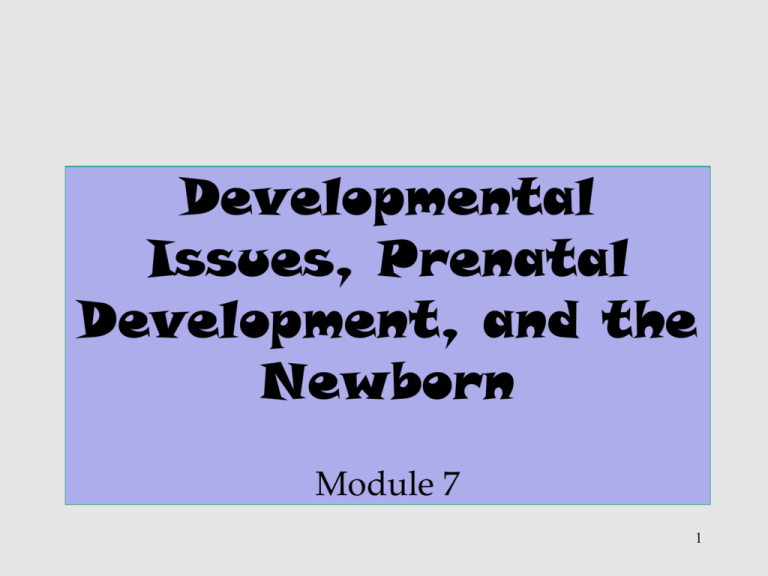
Developmental Issues, Prenatal Development, and the Newborn Module 7 1 Developmental Issues, Prenatal Development, and the Newborn Prenatal Development and the Newborn Two Major Developmental Issues Conception and Prenatal Development The Competent Newborn 2 Prenatal Development and the Newborn BIG QUESTION: How, over time, did we come to be who we are? From zygote to birth, development progresses in an orderly, though fragile, sequence. People used to think that babies began life as a “blank slate” with an empty brain and no abilities. We now know that they are born with innate abilities. 3 Conception A single sperm cell (male) penetrates the outer coating of the egg (female) and fuses to form one fertilized cell. Lennart Nilsson/ Albert Bonniers Publishing Company Lennart Nilsson/ Albert Bonniers Publishing Company 4 Prenatal Development Prenatal Period: the 9 months b/w conception and birth. A zygote is a fertilized egg with 100 cells that become increasingly diverse. At about 14 days the zygote turns into an embryo (a and b). Biophoto Associates/ Photo Researchers, Inc. Lennart Nilsson/ Albert Bonniers Publishing Company 5 Embryonic Stage • During this stage-the genetic plan determines how all the organs will begin to form. • Differentiation: embryo’s cells begin to specialize. • Before differentiation, embryonic stem cells are capable of forming into any organs of the body. 6 Prenatal Development At 9 weeks, an embryo turns into a fetus (c and d). Teratogens are chemicals or viruses that can enter the placenta and harm the developing fetus. Lennart Nilsson/ Albert Bonniers Publishing Company Lennart Nilsson/ Albert Bonniers Publishing Company 7 Prenatal Development of the Brain • Brain grows new neurons at 250,000 per minute. • By birth, it has produced 100 billion. • As the new brain cells are produced, they actually migrate out of the neural tube and then extend their axons and dendrites to make connections with other newly formed neurons. • **How they do this is part of ongoing research. • *the basic plan for wiring the brain—must be contained in the genetic code. 8 Teratogens: Prenatal Toxins • Although the placenta screens out some potentially dangerous substances, many can pass through-including viruses like HIV, certain drugs, and other chemicals-heroin, nicotine, alcohol. • Fetal Alcohol Syndrome (FAS)-symptoms can include mental retardation, poor motor coordination, impaired attention, and hyperactivity. 9 The Competent Newborn Neonatal Period Infants are born with reflexes that aid in survival, including rooting reflex which helps them locate food. Ex. Rooting, grasping, postural reflex 10 Habituation • Defined: a decrease in responding with repeated stimulation. • A novel stimulus gets attention when first presented but the more often its presented, the weaker the response becomes. • This seeming boredom with familiar stimuli gives us a way to ask infants what they see and remember. 11 Recovery • Following Habituation to one stimulus, the tendency for a second stimulus to arouse new interest—often used to test whether infants can discriminate between stimuli. 12 Novelty Preference Procedure • Used it to ask 4 month olds how they recognize cats and dogs. • 1. first showed pictures of cats and dogs • 2. Found that after looking at a series of cats or a series of dogs, they looked at hybrid. • Shows that they focus on face first-not body. 13 The Competent Newborn – Neonatal Period Offspring cries are important signals for parents to provide nourishment. In animals and humans such cries are quickly attended to and relieved. why? Because it’s a behavior parents are predisposed to find highly unpleasant and very rewarding to relieve. Lightscapes, Inc. Corbis Carl and Ann Purcell/ Corbis 14


